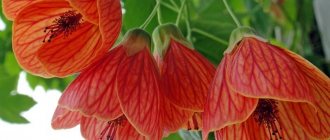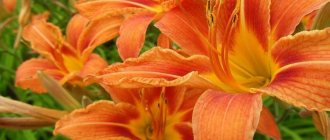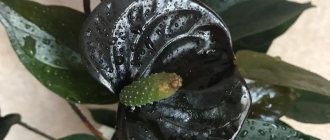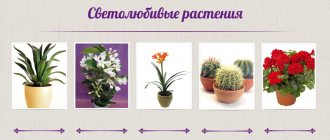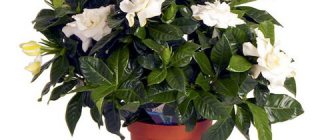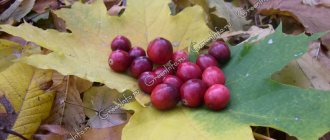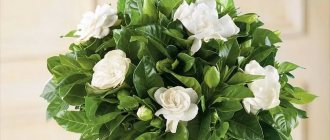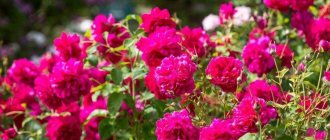Each of us tries to make our home more comfortable and cozy. Flowers add undeniable comfort to any apartment or house, and it is also useful, because indoor plants perform the function of purifying the air. Archaeological science, based on pollen found in caves, has proven that even in the Stone Age, people decorated their homes with flowers. Today, indoor floriculture is a separate science, and from all the variety of house plants, we present the most beautiful indoor flowers.
18 most beautiful types of indoor flowers:
1
Clivia
The beautiful evergreen plant is named after Duchess Charlotte Clive, who was governess to the future Queen Victoria of Great Britain.
This flower arrived in Europe from South Africa, easily took root in northern latitudes and became a favorite of most gardeners.
An unpretentious plant will decorate any home or office space, but you must try not to move the pot and water it once a week.
2
Crassula
The round leaves of this plant look like coins, which is why Crassula is often called “money tree” or “crassula” among gardeners.
When it blooms, it is covered with small white flowers, sometimes red, and very, very rarely the flowers can be blue.
One of the most unpretentious room dwellers. Even a leaf that falls to the ground can sprout into a separate plant.
3
Weed similar to parsley
Weeds and plants similar to parsley can be poisonous. These are buttercup, poisonous vekh, corysh, popularly referred to as Dog parsley, Fool's parsley, Fool's chervil, Poisonous parsley or Znoiha. The genus is represented by Common Kokorysh (Aethusa cynapium) - a one- or two-year-old poisonous plant. It has a branched stem empty inside, growing to a height of 80-100 cm. The leaves are deeply pinnate, with a triangular outline. The leaf blades are diamond-shaped with incised lobes.
The fruit is wide ovoid with keel ribs.
The plant is odorless. It differs from parsley in the waxy coating on the top of the leaf and the structure of the wrapper. It is found in all regions of the European part of Russia on light, rich soils of wastelands, near dwellings, in gardens and in summer cottages.
The toxic properties of the plant are not supported by scientific research, so in the literature there is information about both the toxicity of the cory and its complete harmlessness. Some sources (English Wikipedia) provide information about the toxic effects of Znoika on the gastrointestinal tract of humans and animals, manifested by inflammation of the mucous membranes. Dried fool's chervil is not poisonous as some of the toxins are destroyed by drying.
Lithops
Photo credit: Dornenwolf / flicr
Translated from ancient Greek, the name of the plant translates as “stone appearance,” perhaps because it comes from the rocky and sandy deserts of Namibia and Botswana.
That is why Lithops has learned to retain moisture and easily tolerate heat and arid climates.
The flowers of the desert dweller who migrated to apartments are white or yellow; very rarely there are varieties with orange petals.
4
The main distinguishing characteristics of parsley
Parsley is a small herb of the Apiaceae family that produces seeds in the second year of the growing season. From the Latin name of the species Petroselinum is translated as “mountain celery.” It is grown in a one- or two-year culture. The root is taproot, cylindrical. The leaves are dissected two or three times, have a bright green color with a characteristic shine on the outside.
Petroselinum crispum (P. curly) is the only representative of its species. Has three varieties:
In the first year of development, the plant forms a rosette of leaves and a root, in the second year of vegetation - an erect, branched stem from 30 cm to 1 m with a peduncle. The inflorescences are complex umbrellas with small white or yellowish-green flowers. The seeds of the plant are used for propagation. Essential oil is obtained from them, which is used in cosmetology and the perfume industry.
It is grown for greens, root crops, and in mixed culture.
Curly parsley is used fresh, dry or salted. This is one of the few spices that retains its aroma after heat treatment.
On a note . Essential oil of curly parsley is included in the list of narcotic substances in Russia. Government decree prohibits its use in the production of dietary supplements.
Croton
This species, growing in tropical and subtropical zones, has long become popular among flower growers around the world.
Its bright leaves will add variety and uniqueness to your home, or will become a real decoration for your office. Due to its shape it has become very popular among amateur gardeners.
The plant is easy to care for, and some of its species grow up to 80 centimeters in height.
5
Bromeliad
They named the indoor flower and the entire genus in honor of the Swedish biologist Bromelius. This tropical beauty is a distant relative of the pineapple.
Their leaves are lancet-shaped, they are collected in a kind of rosette from which the peduncle grows. Bromeliads require watering only once a week, but bromeliads should be placed in places that receive sunlight.
Flowering lasts from 3 weeks to several months, delighting the owners and guests of the house.
6
Wintering
Winter is a real test for domestic pines, spruces, thujas, cypresses and other conifers. It is improper maintenance in winter that is the main, and often the only, reason for their death. The most difficult thing is to ensure the desired temperature - in winter it should be in the range of +6–12°C, which is difficult to achieve in room conditions.
The most problems with wintering coniferous plants arise for those who do not have a balcony or loggia. It’s good if the window blocks are of an old design and there is enough space between the frames to place a plant there.
If the coniferous plant is simply kept on the windowsill, it must be insulated as much as possible from heat (for example, using a light frame covered with polyethylene, or an ordinary cardboard box). But if we take into account that there is usually a central heating radiator under the window sill, and the heating here is - let's face it - good, such conditions cannot, alas, be called acceptable for coniferous plants.
But the presence of a well-insulated loggia greatly simplifies this task. The only drawback is difficult ventilation, so you need to think in advance about ways to get fresh air (for example, a small window).
To maintain the required temperature in the loggia, you can use an electric heater connected to a temperature sensor (in this case, when the temperature drops, the heater will automatically turn on, and when the air temperature warms up to +10°C, it will turn off).
You can try to heat the loggia not with electrical appliances, but by pumping warm air from the room. In this case, it will be necessary to make special holes through which, in fact, air flows will flow. The operation of the blower fan can also be controlled using a temperature sensor located on the loggia. If the plant pot is on the floor, the soil may freeze. To heat it, it is good to use a radiant infrared heater.
In case of severe frosts, when it is impossible to maintain the required temperature on the loggia, the pot with the plant is transferred indoors to the coolest place. After a few weeks, the plant will awaken and begin to grow - then it will need additional lighting (how to organize it is described in detail in the article “Basics of proper lighting for indoor plants”).
Geranium
This beautiful indoor plant also has bactericidal properties, so it will not only decorate the room, but will also be useful.
In order for geraniums to bloom constantly, it is necessary to pick off the already fading flowers.
The plant is unpretentious and does not require spraying or frequent watering. Because of its beauty and originality, geranium is one of the most popular inhabitants of apartments and offices.
7
Alocasia
The exotic queen of the tropics has just begun to win the hearts of sophisticated flower growers. Unusual, original shaped alocasia leaves will decorate any room.
In addition, it is unpretentious and does not require special care. Interestingly, different species have different numbers of leaves, but during flowering many plants have only one leaf.
In nature, some species grow up to 2 meters in height, but domestic relatives are from 20 to 40 centimeters.
8
Selaginella
A perennial ground cover plant from the genus Mocopod with very original leaves reminiscent of soft coniferous twigs. The shape of the leaves can be needle-shaped, round, spiral.
The colors are also varied: light green, yellowish, dark green and even almost black with a metallic sheen.
Lacy greenery grows very quickly, forming an intricate pattern. She needs diffused light and good moisture. Heat is destructive for club mosses - the plant withers, sheds its leaves and may even die.
Spathiphyllum
According to legend, this beautiful home flower helps girls meet their betrothed and find feminine happiness.
But with such abilities, it requires special attention to itself, and one cannot say that these are unpretentious indoor flowers. It does not like drafts, but it is better to water it using the cycle method with settled water.
During its flowering period it requires more moisture, but the sun is not so important for it, so it can also grow on windows facing north.
9
Indoor rose
What could be more beautiful than a rose, especially when it blooms on your windowsill. But this queen of flowers requires special care.
The home rose simply loves sunny color, so it is better to place it in a well-lit place on a western or eastern window.
If you care for them properly, roses will bloom all year round, every 7-8 weeks.
10
Fuchsia
Once upon a time, flowering indoor plants accepted fuchsia, a native of Australia and Latin America, into their family. And what is noteworthy is that she immediately took a leading position in home floriculture.
This flower was also revered by the American Indians, and the Incas considered it sacred and decorated their homes and places of worship with flowers.
Fuchsia is unpretentious, and the only thing it really loves is the diffused sunny color. On the pages of the website most-beauty.ru we wrote about this plant in an article about the most beautiful flowers in the world.
11
Popular plants
- Zamioculcas (Dollar Tree)
- Kalanchoe
- Spathiphyllum
- Dracaena
- Poinsettia (Christmas Star)
- Cyclamen
- Poinsettia (Christmas star)
- Ficus benjamina
Sources
- https://glav-dacha.ru/komnatnye-cvety-katalog/
- https://WhatFlower.ru/houseplants/katalog-komnatnyx-rastenij-s-foto-i-nazvaniyami/
- https://zen.yandex.ru/media/id/5c151cc0330a1400aacd326f/samye-neprihotlivye-komnatnye-cvety-i-rasteniia-uhod-za-nimi-5c16b21b2fb96d00aa8d19e4
- https://rasteniya.dp.ua/ru/komnatnie-cveti/
- https://moyasotka.com/tsvety/komnatnye
- https://zen.yandex.ru/media/moiorhidei/14-neprihotlivyh-domashnih-rastenii-kotorye-mogut-cvesti-kruglyi-god-5d9da6771ee34f41895508c9
- https://uutvdome.ru/bol-komn-ras
- https://most-beauty.ru/nature/samye-krasivye-komnatnye-tsvety.html
- https://RoomFlower.ru/poleznoe/poleznye-komnatnye-rasteniya.html
- https://stroy-podskazka.ru/komnatnye-cvety/samye-populyarnye/
- https://agronom.guru/komnatnye-cvety-s-foto-i-ih-nazvaniyami
- https://rastenievod.com/category/komnatnye-rasteniya
[collapse]
Hibiscus
But this is not really a flower, but a shrub that came to the Old World from the hot tropics. Evergreen hibiscus, blooming from early spring to late autumn, will decorate the room.
It should be kept in the southern part of the house, where there is a lot of light, and watered regularly and preferably with settled, not cool water.
The only thing that this most beautiful of shrubs cannot tolerate is sudden temperature changes and drafts.
12
Hippeastrum
Often this representative of indoor fauna is mistakenly called Amaryllis; in Greek it is a combination of two words “horseman” and “star”.
A flower with a romantic name loves bright light and is very thermophilic. This is not surprising, because he arrived in Europe and America from the warm latitudes of South Africa.
When flowering, it produces magnificent bright red or pink corolla-shaped flowers.
13
Hyacinth
This house flower, a member of the large Asparagus family, can bloom in a variety of shades from bright red to white and purple.
Recently, due to its original shape and beauty, it has become a fairly common species among gardeners. In addition to the house, there are species that get along well in the garden.
Hyacinth flowers are widely used in the perfume industry, and during the flowering period, hyacinth itself has a pleasant aroma.
14
Herbs similar to parsley
When buying parsley for greens, it can be confused with some herbs. This is not surprising, because they all belong to the same family. In addition to parsley, cilantro, celery, and lovage have dissected leaves of a similar shape. Spicy plants can both smell and stink at some stages of development.
Externally, a bunch of cilantro is difficult to distinguish from parsley
Cilantro
Cilantro is a green herb that is most often confused with parsley. Their leaves are very similar. On a shelf in a supermarket you can't tell at first glance. To the touch, cilantro leaves are more delicate and small. You can distinguish greens by the aroma exuding from the mashed stem.
Plants in the garden bed are easy to identify in the second year of life. Coriander seeds are round, larger than those of parsley. The stem is less leafy, the flowers are pink.
On a note . Cilantro is the colloquial name for coriander (Coriándrum sátivum). its leaves are used as herbs, its seeds are a well-known spice. In some places, cilantro is called Chinese parsley, sowing kishnets, kishnishi, kinji, shlendra, kashnich, kolyandra.
Cilantro is a source of many beneficial substances that has a beneficial effect on the human body. It contains a large amount of vitamin K, which affects the overall composition of the blood, normalizes the functioning of the excretory system and liver, and can minimize the effect of certain types of toxins.
It differs from parsley in its unpleasant odor during flowering. Because the plant smells like bedbugs, it is not popular on European tables and is most often called a herb similar to parsley with an unpleasant odor.
Celery stalks are widely used for making fresh juice.
Celery
Celery is a herb from the Apiaceae family. The most famous vegetable plant is celery (Apium graveolens) - an aromatic plant with a negative calorie content.
Cultivated as an annual or biennial plant. The leaves are twice pinnately dissected. It has a tall (up to 1 m) branched stem, the root is very thick and spherical. The inflorescences are an umbrella with greenish-white flowers.
Juicy green stems are used to prepare fresh juice, a trend in recent years. Seasonal greens not only replenish the body with nutrients, but also help get rid of extra pounds. Celery is number one on this list.
Leaves, stems and roots are used for food. The latter are valued for their low calorie content (half that of potatoes) and unusual sweetish taste. Soups with roots do not differ in taste from meat broths. The leaves have a specific aroma and are used as a seasoning. The stems are juicy and crispy - the basis of freshly prepared drinks. They act as an antiseptic, remove toxins, and enhance the breakdown of cellulite deposits.
Lovage
Almost every garden grows a spice that vaguely resembles parsley.
Lovage is the name of a genus of perennial grass of the Apiaceae family, which is represented by the species Lovage (Levisticum officinale). In Russian it has many synonyms: love-grass, lyubets, lyubchik, love and love potion. It grows in the wild only in Iran and Afghanistan, and is cultivated everywhere. It has a powerful stem up to 2 m high, branched in the upper part. The root system is developed, with a thick root. The leaves are large, shiny, dissected into obovate or diamond-shaped lobes. The flower is small with a yellow tint.
cacti
Be that as it may, but a prickly flower during the flowering period, even if this happens very rarely, you simply cannot take your eyes off them.
And it can please you with flowering only with proper care and compliance with watering requirements. Everyone probably knows that cacti are not watered in winter.
This is a heat-loving plant, so it loves bright light and prefers to be in the southern part of the house.
Begonia
Graceful and majestic begonia has long won the hearts and souls of flower growers and lovers of beauty. It is noteworthy that leaves and flowers can take on a variety of, and sometimes quite bizarre, shapes.
Loves sunny color and regular watering. With proper care, it will delight you with the blooming of beautiful colorful flowers.
This genus is the most common and numerous in the large Begonieceae family, and somewhere in space there is an asteroid named after this flower.
16
Poinsettia
The first Spaniards who arrived in South America met a beautiful flower in the tropics, and local ethnic groups spoke about its healing and magical properties.
The second name simply screams about the magnificence of the plant - the most beautiful Euphorbia, and today it is widespread as an indoor flower in every corner of the world. For a long time there was a misconception that the plant is poisonous, but this is not so. It is harmless and even useful, ionizing the air in the room where it grows.
17
Poisonous herb similar to parsley (veh poisonous)
In nature, there are wild plants that are similar in appearance to parsley and have strong poisonous properties.
Veh poisonous (Cicúta virosa) is the most poisonous plant belonging to the Umbrella family. The plant is inconspicuous: a thin stem, small white flowers are collected in umbrella inflorescences. Vekh, similar to healthy parsley, is not much different from all the safe Umbrellas. May appear under the names:
All parts of the plant are poisonous. The most cicutol is found in the rhizome: 100 grams of root is enough to kill a cow.
Mistaking hemlock leaves for parsley, a person is at risk of poisoning, which manifests itself a few minutes after ingestion. Toxins manifest themselves as nausea, leading to vomiting, and cramps in the lower abdomen. If you do not resort to intoxication, dizziness, a “drunk” gait, and foam begins to emerge from the mouth. The pupils dilate and epilepsy attacks may occur. Large doses cause severe muscle contraction and can be fatal.
The insidiousness of the plant is that it has a pleasant smell of carrots, the rhizome tastes like rutabaga.
If you suspect poisoning with a poisonous weed, it is necessary to rinse the stomach with a large amount of a solution of a mixture of activated carbon and tannin.
Schlumberger
A flower with such an unusual name belongs to the cactus family, but among gardeners there are many names: “Decembrist”, “Christmas cactus” or simply “Christmas cactus”.
When it blooms, it usually blooms very luxuriantly and for a long period of time. It is better to place it in bright places, but without direct sunlight. Like all cacti, it requires moderate watering, but during the flowering period it is necessary to water it abundantly and maintain high air humidity.
18
Tips for choosing large sizes
A few tips will help you choose the most suitable “green” large size:
- Find out in advance how quickly a particular plant grows. After all, some of them reach large dimensions only after a few years.
- If you want to get significant sizes quickly, then it is better to buy an already mature specimen or choose fast-growing species.
- Before purchasing, think in advance about where it is best to place your green friend, and whether the chosen location meets the necessary conditions (lighting, air humidity, etc.). It is important that this or that plant is in the most suitable environment for it.
- If you choose a plant with a large height, then you need to place it in a room with appropriate ceilings.
Some care tips:
- Some specimens require additional support in the pot.
- Initially, you need to plant it in the right pot, suitable in size (height, width, diameter), with drainage holes. In a small pot, the root system will not be able to develop normally, and in a pot that is too large, water may stagnate in the soil.
- To protect the plant from stress, it is advisable that it stands in one place throughout its entire life.
Thanks to the relatively large selection, you can choose the most suitable potted plant for your room or office. The choice may fall on either a flowering specimen, or a decorative deciduous variety with large or fleshy leaves, or a tall one. Remember, in order for a large plant to delight you with its decorative properties for a long time, it is necessary to take good care of its potted “friend”.
Primrose
Let’s complete the review with a representative of the Primrose family, the most beautiful and original flower, Primrose. The name in Latin is exactly that - “first”.
Whole, carved leaves form a basal rosette. But the primrose blooms with multi-colored flowers of bizarre shapes and an incredible aroma.
It is best to place primroses in brightly lit places, but without direct sunlight, in the southern part of the apartment or house.
Wild herb similar to parsley (creeping buttercup)
In the wild you can find a herb similar in appearance to parsley.
Creeping buttercup is a representative of the Ranunculaceae family, growing in wet meadows, forest bolts, vegetable gardens and summer cottages located in the lowlands. Perennial, has a thick, succulent, pubescent creeping stem with thickened internodes.
The lower leaves are tripartitely divided, unequally toothed, on petioles. The upper ones are seated on the stem, tripartite, elongated.
The flowers are relatively large (diameter 2-3 cm), regular in shape, with five petals of bright yellow color, collected in inflorescences.
